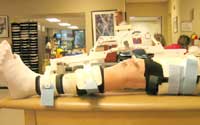Dr Dirk Kokmeyer illustrates those rehabilitation principles that are important in preventing arthrofibrosis of the knee after injury or surgery.
 First published 2007, and reviewed August 2023 by Dr Sheila Strover (Clinical Editor)
First published 2007, and reviewed August 2023 by Dr Sheila Strover (Clinical Editor)
- Principles of arthrofibrosis rehabilitation
- Patellar Mobilisation
- Restoring Quad function
Knee arthrofibrosis can be an extremely frustrating and debilitating condition.
If you have been diagnosed with this condition, rehabilitation for it - whether this be post-operative or non-surgical - should be approached cautiously and appropriately.
Rehabilitation and range of motion
It is important to understand the principles of rehabilitation for arthrofibrosis and also to understand that they are very interdependent. In the intial phases of the disease and in the postoperative period, inflammation and joint swelling typically limit motion and contribute to further scarring. If this is not treated in appropriate and timely fashion, this can lead to permanent motion loss. Decreasing swelling and preventing inflammation is essential to maintaining and increasing motion. Weight bearing is also another important variable. When the knee is loaded by early weight bearing activities or aggressive strengthening, recovery from an inflammatory process will only be delayed or exacerbated.
Decrease swelling and prevent further inflammation
Although there are varying opinions about weight-bearing in the leg postoperatively, we recommend using crutches for 1-2 weeks to allow the initial inflammatory phase of healing to pass. With a knee that maintains significant joint swelling, prolonged use of crutches should be considered.
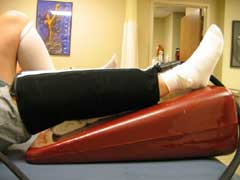
Rest, Ice, Compression and Elevation or RICEing the knee are recommended to decrease swelling: rest keeps the load off the knee; ice cools the knee, decreases blood flow, and provides pain relief, which helps to reduce pain and need for medication; compression and elevation in combination with ice has been shown to reduce swelling better than no treatment at all.
Modalities, such as electric stimulation, ultrasound, iontophoresis and phonophoresis can also be used to decrease swelling. I have used high-volt electric stimulation at a low frequency (this will cause involuntary muscle contractions that create a muscle pumping effect on the quads) in combination with RICEing the knee with difficult joint effusions. I have also used iontophoresis, which is the application of a medication (usually dexamethazone or ketoprofen for swelling) using a mild electric current to drive the medication under the skin. This has been shown to drive a medication as deep as 2 cm into the body.
The literature supporting the use of some modalities is very contradictory. Each modality has limitations and the appropriateness of a modality should be determined by your therapist.
Restore Mobility
Passive Range of Motion (PROM)
Initially, passive range of motion (PROM) exercises are used to help restore mobility. These exercises include wall slides, sitting flexion-extensions and stationary biking without resistance. Keeping the mobility exercises passive will ensure that the knee is not loaded.
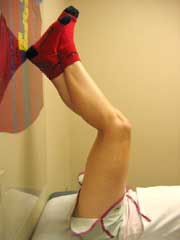 |
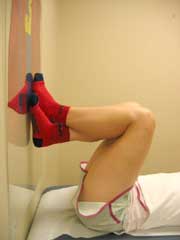 |
|
Wall Slide (left leg is involved in the above pictures) While lying on your back with your buttock about 1 foot from a wall, use the uninvolved leg to support the involved leg. The uninvolved leg then guides the involved leg up and down the wall. I prefer this exercise to assist with flexion as gravity will help to bring the knee to maximum, end-range flexion. |
|
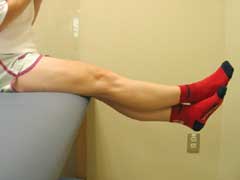 |
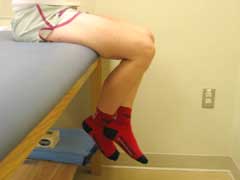 |
|
Seated Flexion/Extension (right leg is involved in above pictures) In a seated position, use the uninvolved leg to extend (left picture) and to bend (right picture) the involved leg. Allowing the involved leg to do the work helps to keep this exercise passive for the involved leg. |
|
Our post-operative regimen includes these PROM exercises, beginning on the day after surgery. We also recommend the use of a Continuous Passive Motion (CPM) machine during hospitalization and a week or more after surgery this is determined by the surgeon.
The CPM is used to prevent joint stiffness and maintain mobility, but it should be understood that the CPM does not typically improve the motion from that gained during manual stretching or from that obtained at surgery. Range of motion exercises, stretching and manual mobilization are more effective at achieving this goal.
It should be noted that restoring ROM to what is considered 'normal' - by definition of what an uninjured, healthy knee can achieve - is not always the goal. If this is a knee that has had surgical intervention, specifically for this condition, the amount of mobility that can be achieved will be close to what was achieved in the operating room, under anesthesia.
Low Load Prolonged Stretching
Another helpful tool to increasing ROM is Low Load Prolonged Stretching (LLPS). This type of stretching involves holding a joint in a mild to moderate stretch for a prolonged period of time.
The theory behind this type of stretching is that the prolonged stretching creates more permanent change to tissues that are restricting motion. It has been shown to be effective at increasing motion, however these studies have not specifically addressed use of this stretching on arthrofibrotic knees. From my own personal experience, I recommend use of this type of stretching in addition to PROM, manual mobilization and stationary biking.
LLPS Braces
The Dynasplint is a spring loaded brace that holds a joint in its restricted position (i.e. knee extension). The protocol for this brace advises wearing it overnight while you sleep. The springs in the brace keep the stretch dynamic; as the motion improves, the brace applies a constant and continuous amount force to the knee. We have found that our patients have a difficult time sleeping with this brace comfortably, regardless of how lightly the springs are set.
The JAS Brace is a static stretching brace. It uses a ratcheting system to apply a constant force into the restricted motion. Force can only be increased by the user of the brace. The protocol for this brace is two stretching sessions a day for 30 minutes each session.
Both the Dynasplint and JAS Brace are helpful tools to increasing joint motion. The drawback is that they are expensive if insurance does not cover them. Both of them work on a monthly rental basis and rental must be arranged through a company representative.
Self LLPS Stretching
I have found that these types of stretches can be achieved without the use of braces, though the LLPS braces can assist with the rehab of an arthrofibrotic knee.
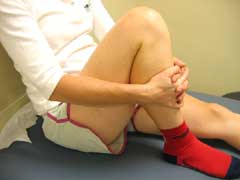 |
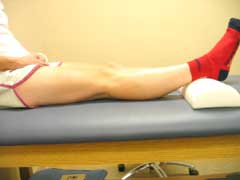 |
|
Flexion LLPS For flexion, sitting and holding the knee in flexion at a mild to moderate stretch ( I define this as a 3-5/10 stretch on a scale of 1-10, 10 being the highest amount of stretch perceived) for 10-30 minutes, as tolerated. |
Extension LLPS To achieve more extension, sit with your leg supported under the ankle and foot, as if you are sitting with your foot on a coffee table. For the same amount of time and intensity described above, let the knee hang. Using a light weight, placed on the knee, above the kneecap, will help to make the stretch more intense |
Flexion LLPS
For flexion, sitting and holding the knee in flexion at a mild to moderate stretch ( I define this as a 3-5/10 stretch on a scale of 1-10, 10 being the highest amount of stretch perceived) for 10-30 minutes, as tolerated.
Extension LLPS
To achieve more extension, sit with your leg supported under the ankle and foot, as if you are sitting with your foot on a coffee table. For the same amount of time and intensity described above, let the knee hang. Using a light weight, placed on the knee, above the kneecap, will help to make the stretch more intense.
INTRODUCTION: Arthrofibrosis rehab tutorials
NEXT PART: Patellar Mobilisation
